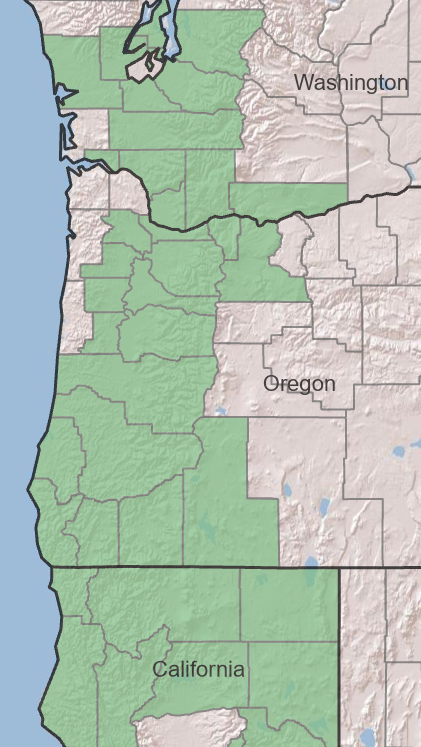Written By: Anne Ternes
- Scientific Name: Fraxinus latifolia
- Canopy Layer: Overstory (at maturity)
- Attracts: Bees, Butterflies/Caterpillars, Aquatic Invertebrates, Birds, Beavers, Deer & Elk
- Portland Plant List: Yes!

The ash of the Pacific Northwest, Oregon ash is a wetland supertree. It stabilizes wetland soils and filters out pollutants. It provides food and habitat for all the usual suspects, bees and birds and small mammals, as well as aquatic insects, crustaceans, waterfowl, and aquatic mammals. In addition, Oregon ash supports dozens of species of butterflies and moths. Easy to grow, strong and sturdy, and a magnet for wildlife, Oregon ash is the tree your soggy soil has been waiting for.

Oregon ash is native to the west coast of North America. From British Columbia, its range stretches south, staying on the west side of the Cascades before reaching California, extending more inland along the Sierra Nevada mountain range. Throughout its range, Oregon ash is found in wetlands and riparian forests. Within these two habitat types, Oregon ash prefers full sun but will tolerate partial sun. This tree is not as picky with its soil type as it is with habitat and sun, preferring clay or silty clay but growing well in sandy, rocky, and gravelly soils. Do you want a tree to shade your pond or stream, or do you have a spot that regularly floods or a rain garden that could use some cover? Oregon ash is perfect for all these areas. It also works well as a border tree for meadows as long as the soil is regularly moist.

Oregon ash cuts a dominant yet elegant silhouette with its slender trunk and broad, dome-shaped canopy. Smooth, rounded leaves grow near the ends of stems and branches, leaving the interior of the silhouette open, perfect for birdwatching. Before the new leaves begin growing in, the springtime flowers have their bloom. Growing close to the branches, Oregon ash’s flowers look more like miniature artichokes or jelly bean succulents than flowers. As the flowers are pollinated and developing fruit, new growth begins poking out and extending rapidly into pale green, fuzzy branches. As fall nears, hundreds of ripening samara fruits can be seen dangling from the branches. The samaras begin to glide down when fall is underway, and the green in the leaves begins to fade to yellow and gold before they follow the samaras.

At maturity, Oregon ash reaches heights of sixty to eighty feet and a width of twenty-five feet, setting it firmly in the overstory canopy layer. Oregon ash grows quickly when it is young, often reaching thirty feet by ten years before slowing its growth. As with all overstory trees, Oregon ash reduces soil erosion by breaking the speed of falling rain and anchoring soil with its roots, but being a wetland tree, Oregon ash provides so much more. It protects watersheds by stabilizing streambanks and filtering pollutants out of the water. In terms of wildlife, Oregon ash’s attraction is no less critical, playing host, food source, and material source to many native animals. Water birds, upland birds, and songbirds rely on Oregon ash for shelter, food, and nesting material. Bees have been known to collect ash pollen to use in their nests. Aquatic invertebrates rely on the leaf litter provided by Oregon ash as detritus and shelter material. Meanwhile, over fifty-three species of butterflies and moths in the Portland-Vancouver metro area rely on Oregon ash as a food source, larval host, and habitat. At least one of these species, Sympistis fortis, relies solely on Oregon ash. As for mammals, Oregon ash provides food for squirrels, beavers, deer, and elk. All in all, Oregon ash covers just about everything: soil protection, water protection, and food and shelter source for insects, aquatic invertebrates, birds, and mammals.

Have a little wetland that needs a tree? Oregon ash is perfect, not only for the multitude of reasons listed above but because it is readily available. You can find it at most nurseries as seed, bare root, or a sapling ready to plant. It may require extra attention as it establishes itself, especially protection from herbivores, but will require very little once established. Oregon ash grows well with other native trees, including red alder, bigleaf maple, Oregon white oak, and black cottonwood. In addition, consider co-planting Indian plum, snowberry, lady fern, common horsetail, fringecup, or slough sedge for a beautiful and dynamic native habitat (see the Portland Plant List for a comprehensive list of native riparian and wetland plants).
Sources:
- “ash.” nwf.org/NativePlantFinder. U.S. Department of Agriculture, Forest Service, Nation Wildlife Federation, University of Delaware. https://www.nwf.org/NativePlantFinder/Plants/1359
- “Fraxinus latifolia.” plants.ces.ncsu.edu. North Carolina State University & North Carolina A&T State University. https://plants.ces.ncsu.edu/plants/fraxinus-latifolia/
- Portland Plant List. Bureau of Planning and Sustainability, City of Portland, Oregon. 2016. Pgs. 3.2-2, 3.3-1, 3.5-1, 3.17-1. https://www.portland.gov/sites/default/files/2018-12/Portland_Plant_List_2016_Update_Final2.pdf
- Owston, Peyton W. “Fraxinus latifolia Benth.” srs.fs.usda.gov. United States Department of Agriculture, Fire Systems, Southern Research Station. https://www.srs.fs.usda.gov/pubs/misc/ag_654/volume_2/fraxinus/latifolia.htm
- Selviaggio, Sharon. “”Trap Trees” Offer A Promising Approach To Slow The Spread Of Invasive Emerald Ash Borers.” xerces.org. Xerces Society for Invertebrate Conservation. Sept. 22, 2022. https://www.xerces.org/blog/trap-trees-offer-promising-approach-to-slow-spread-of-invasive-emerald-ash-borers